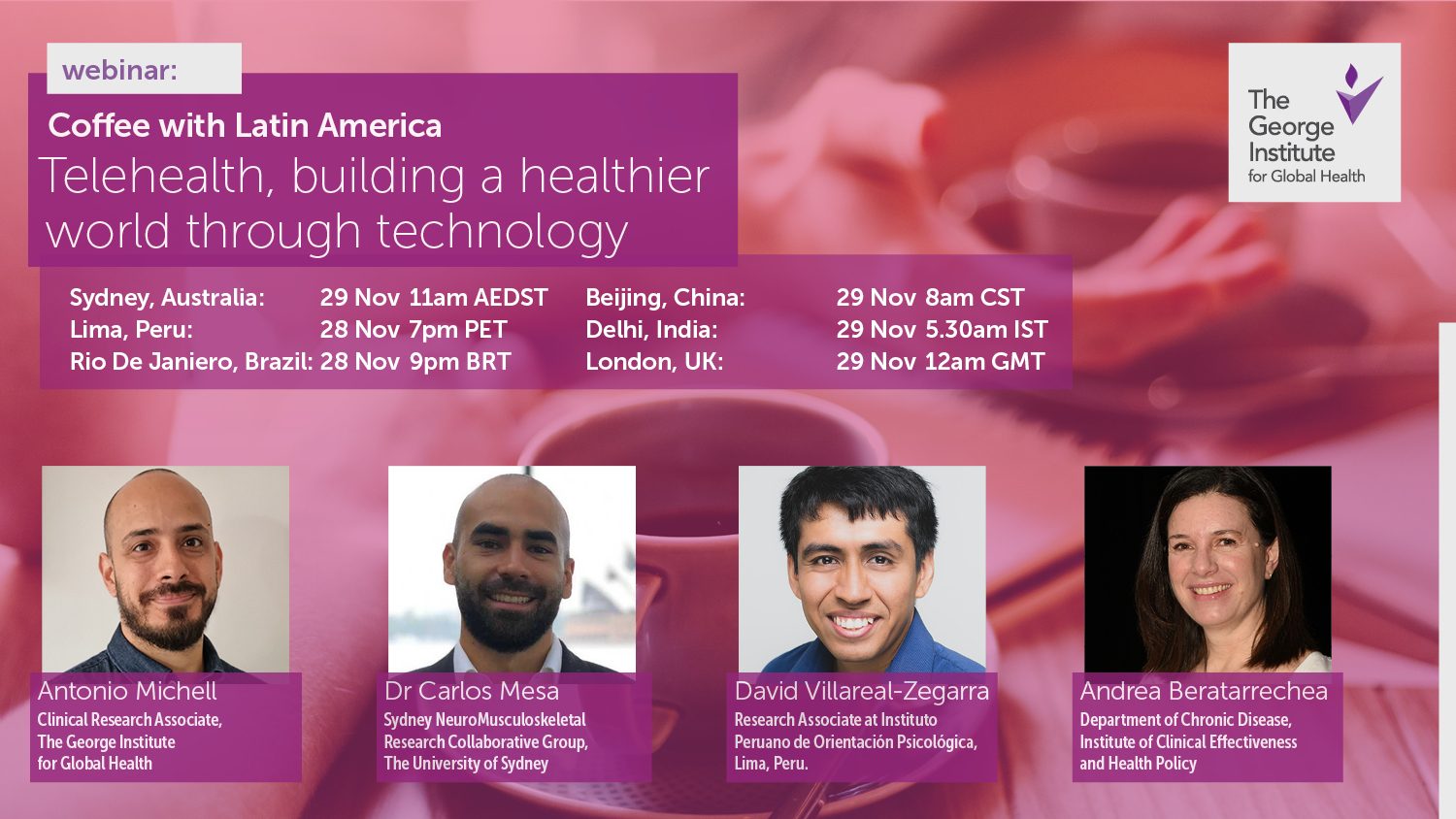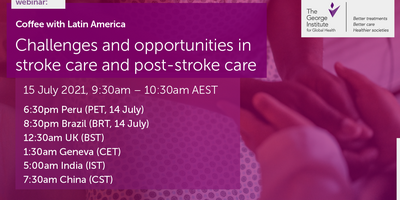
Blog: Reflections- Key take outs and reflections from ‘Coffee with Latin America: Telehealth, building a healthier world through technology’
Telehealth is a way we connect and treat when physical meeting is difficult. The benefits and challenges have been thrown into the spotlight even more since the necessity of telehealth through the pandemic.
To discuss this, Coffee With Latin America 'Telehealth, building a healthier world through technology’ was held on the 29th of November 2022. Four speakers from Peru, Colombia, Argentina and Chile shared their experience of using information and communication technology to deliver health services and increase healthcare access.
‘Coffee with Latin America’ and ‘Tea with Africa’ are part of The George Institute’s initiative aimed to promoting discussion around various health related topics to foster partnership and collaboration with health researchers around the world.
Key points from presentations
Dr. Carlos Mesa: ‘EMPoweR People with musculoskeletal pain in Rural communities (EMPoweR): a randomised controlled trial’
Carlos discussed a study comparing the effectiveness of two approaches on physical function, pain and disability in people with chronic low back pain or knee osteoarthritis in rural Australia.
- The randomised controlled trial compared usual standard care with an eHealth intervention that delivered a physical activity program remotely.
- For the standard care, participants were offered assistance over the phone on how to find healthcare in their communities and a referral letter to appropriate health experts. In the eHealth intervention, participants received up to 8 remote health coach teleconsultations over 3 months, as well as individualised home exercise training program on progressive resistance and a physical activity plan with fortnightly goal setting.
- The study found that after 3 months, patients receiving the eHealth intervention had clinical improvement of physical function and had also improved disability compared to patients receiving usual care. This supports the use of real-time teleconsultations to improve access to care in rural Australia.
The study showed that digital health interventions are well accepted in some rural communities and have the potential to improve access to health services. Relating this to potential use in Latin America, Carlos identified that potential barriers include limited internet connection in rural areas, the need of physical infrastructure for e health implementation, lack of knowledge of the digital health literacy level of the population, language barriers among ethnical populations such as indigenous people and the existing paradigm that care should be face-to-face.
David Villarreal-Zegarra: ‘Mental and Digital Health in Peru’
David discussed a systematic review his team conducted to develop a framework for digital implementation of mental health.
- Peru is a middle-income country with a fragmented health system. Peru is currently going through a mental health reform that is shifting its focus from hospital-based to a community-based focus and is going through a digital transformation.
- It is important to understand how the digital transformation can be accelerated. The systematic review was conducted to identify a framework that would facilitate this.
- One of the key lessons from the systematic review was the need to contextualise the information. Most evidence found in the systematic review was from high income countries that have contexts very different to those in Latin American countries, where legislation around digital health has only started very recently.
David finished by highlighting the need to maintain good communication with decision and policy makers to be able to identify regulatory frameworks when translating and implementing evidence into local contexts.
Andrea Beratarrechea: ‘Use of two e-learning modalities for diabetes education using Facebook in two cities of Argentina during the COVID-19 pandemic: a qualitative study’
Andrea discussed the findings of a study conducted in two cities of Argentina to deliver diabetes education using Facebook during the COVID-19 pandemic
- Although it is well known that patient education can improve health outcomes, patient satisfaction, and reduce healthcare costs, access to patient education in Argentina is low.
- A national survey showed that only 2 out of 10 patients with diabetes received diabetes education. More barriers to receiving diabetes education were added during the COVID 19 lockouts given the physical confinement and people’s fear of going out.
- Dr Beratarrechea’s study explored 2 modalities of e-learning (synchronous and asynchronous) for diabetes education using the Facebook pages of public health institutions in Chaco and La Rioja, Argentina. They found that both were acceptable and feasible and each had particular advantages.
- In terms of implications for practice, it is important when designing e-learning strategies using social media to take into account the modality, the needs of the target population, access to internet connectivity and the type of social networks.
Andrea concluded by stating it is very important to implement a monitoring process of the participant’s posts and provide feedback to those posts as well as implementing strategies to motivate interaction and utilising amplifying channels such as the webpages of health or community centres.
Antonio Michell: 'Telerehabilitation implementation, challenges for Australia and South America’
Antonio discussed the history of telehealth and lessons for implementation in Latin America.
- Most evidence of telehealth implementation to date is from developed countries.
- To help address evidence gaps, Antonio’s study compared the implementation of telehealth in South American countries with Australia during the COVID-19 outbreak.
- The findings of the study suggested that implementation of tele-rehabilitation depends on the cultural and health characteristics of each country as well as on the local geography.
- According to a national survey, the most prevalent barriers to telehealth implementation from a clinician’s perspective were 1) the perception that rehabilitation services have to be delivered in a face-to-face setting, and 2) clinician’s lack of experience with tele rehabilitation.
- Antonio is currently working on a nation-wide survey to determine the experience and perceptions of physiotherapists and users of the therapeutic service offered via telerehabilitation during the COVID 19 pandemic.
To finalise Antonio shared some lessons. First, he emphasised that a therapeutic alliance is possible and said that developing good communication skills is crucial to be able to transmit knowledge effectively to patients. Antonio also stated that technology should be perceived as an ally rather that a threat and that embracing change is needed to overcome some of the barriers to implementing tele rehabilitation.
Questions from the audience.
Once the panellists finished their presentations, they answered questions from the audience. Some of the questions asked and the answers given by the speakers have been summarised below.
Qu: Regarding the first paper on implementation frameworks and your use of a realist methodology, how does this help us understand generative causative mechanisms?
A: David Villarreal-Zegarra- The realist synthesis methodology allows us to establish possible causal mechanisms and place them in a given context to explain health outcomes. Our study allowed us to understand how the evidence supports certain causal mechanisms to explain the presence of outcomes in the implementation of digital mental health interventions.
Qu: Do you think that some medical areas are not able to change to telehealth? did you found something related about it in the review?
A: David Villarreal-Zegarra - In severe cases such as suicidal behaviour or self-injurious behaviours, it could be very complicated to be managed solely with the use of technology. Digital intervention could be a way to ask for help, but the treatment, in that case, would be mainly face-to-face.
Qu: Your study sounds interesting and a model to learn from, especially regarding Peer support. How would you change the design from the future models?
A: Andrea Beratarrechea -Peer to peer interaction in face-to-face diabetes educational sessions implies starting a conversation with another person with diabetes. This can be implemented using social media but it is important to have a moderator to avoid misinformation which can occur in the interaction between peers.
Qu: Do you have any concerns about the equity-related impact of the telehealth interventions your study proposes?
A: Antonio Michell - That actually is the main challenge when implementing telehealth in South American communities, as lack of resources, digital literacy and economic disadvantage play a huge role in the implementation of new technologies.
Concluding remarks from the speakers and attendees
Jaime Miranda opened a final discussion by asking all panellists what they would do different if they had the opportunity to start again.
Andrea: foster more peer-to-peer interaction and make sure that shared information is accurate.
David: involve more decision and policy makers from the beginning of the systematic review to be able to know the perspective of those who are in charge of translating and implementing the evidence.
Carlos: try an automated app or a combination of synchronic and asynchrony methods to give feedback to participants and keep to them engaged with physical activity and setting up goals.
Antonio: get perspectives from government organisations, business and private organisations about implementing telehealth and involved them in the process of digital implementation. He added that the main and most complex thing of implementing tele services in Latin America is that the populations’ literacy levels and access to internet are different to developed countries.
Jaime added that a common point in all the presentations was the need to tailor interventions to the specific context to be able to serve the target populations. In addition, he said that tele health is one of the many elements of innovation that are being integrated to complex systems and then the challenge is to find out how to effectively nest these interventions to the existing systems.
To finalise the panellists agreed that working together with patients, clinicians and policy makers is key to being able to translate evidence into effective implementation of e-health services.
Reflections from the attendees
At the end of the session, attendees were encouraged to share some reflections and highlights from the webinar. Below are some of the comments from the participants.
- Christine Jeyachandran
“I found the webinar about Latin America to be a way to open people’s eyes to the learnings we can make across the world and Latin America in terms that could influence future study design/ policy.” - Andrea Beratarrechea
" In LATAM, the COVID-19 pandemic showed that digital health technologies constitute an important tool to deliver health interventions sometimes at a lower cost and saving provider´s time. However, a successful implementation requires reshaping the healthcare system, provider´s work and healthcare practices as was observed in the work presented during the webinar sessions." - Antonio Michell
“Thank you so much for organising the Coffee with Latin America. It was a pleasure to be part of the team, I learnt a lot from you during the process and really enjoyed the event.” - Jacqueline Seiglie
“Wanted to second Christine's comments regarding how enjoyable and eye-opening this seminar was! Beyond the excellent content matter (i.e., the versatility of mHealth across a wide range of modalities, health conditions, and study populations), it was great to see such talented LATAM researchers carrying out innovative and important research. Overall, I think this forum is an excellent opportunity to "build community" across the LATAM region and a great way to connect people with similar interests, and potentially catalyse future collaboration. Very much looking forward to the next one” - Camila Kairuz
“The adaptation processes that the world had to make to deliver healthcare services during the COVID-19 pandemic evidenced that tele health is feasible and well accepted. Tele-health has also been known as a possible solution to deliver healthcare services to people located in remote areas and as a way of increasing health equity. This webinar supported those hypotheses and allowed participants to share ideas and experiences regarding telehealth implementation in Latin America.” - Carlos Mesa Castrillon
“The meeting is a friendly space that facilitates sharing of research ideas from scientists with diverse cultural backgrounds and innovative ideas. It is led by fantastic researchers who encourage the conversations and simplify the engagement with the attendees.”






